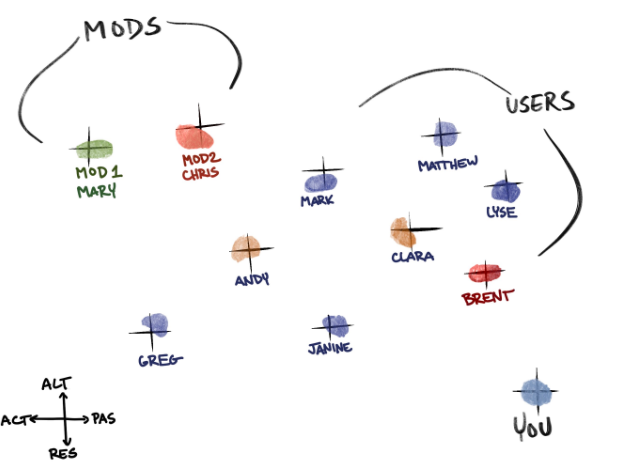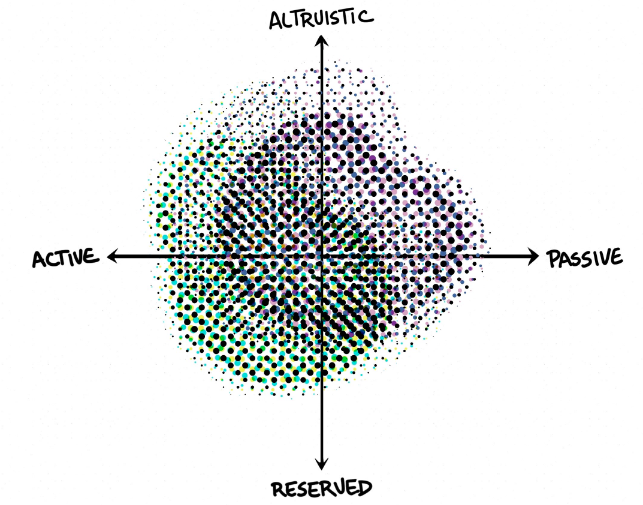How To Navigate Social Groups In VR
Sometimes, things happen online that you can't predict. Here's a guide to help.

In our previous guide of how to stay safe in social VR, we examined some common rules of navigating virtual reality before you encounter a problem. But what if you already have, or just want more technical help? What if you don't know how to evaluate a group to see if they're right for you?
The following involves a more detailed tool readers can use to maneuver digital spaces in peace. It gets a bit heavy, but we hope it helps you in the long run.
Meet Bob.

Bob is an accountant from Wisconsin. Chicago. Houston. Wherever. He's Bob and he lives a bit of a dull life.
The graph detailing Bob's personality above is pretty straightforward. It charts only two things: his level of openness towards others, and his willingness to lead others in any given situation. The parameters that form a shape on Bob's chart show the range of extreme situations that might shift those values (the outer area). Bob is average, so he shows a reasonable range of openness when there's an emergency or unusual incident, and a certain level of shyness when he's around people he doesn't know.
Now, meet Alyssa.

Alyssa is a lot more outgoing than Bob. She initiates conversation first where Bob doesn't, but she's a lot more reserved when it comes to doing favors for people she doesn't know--unless there's an extreme circumstance. Alyssa has a different way of seeing the world, shaped by who she is and the personal experiences which extend from her being. Alyssa and Bob have a lot of life wisdom they could probably share with one another.

Except for one thing: Alyssa is Bob, when Bob is logged into virtual reality. Or, Bob is Alyssa. One shifts into the other in the special circumstance of entering VR, their other self emerging a little more because of it.
The Virtual Personality Index

This graph is called the Virtual Personality Index. The Virtual Personality Index is a social analysis tool that is a nuanced, digital version of influence mapping (which itself has roots in stakeholder analysis). Influencers exist in social groups who can sway opinion and work entire rooms to change conversations. Influence mapping is an aid to identify where influencers are in certain groups.
Although the Virtual Personality Index is a visual tool, it's intended to be a quick reference. Hence the fuzziness of the personalities charted--you don't have an exact measure for any personality when you meet someone, but you can sort of estimate the parameters of their being after you observe them for a while.
Remember: it's mental math, not a physical chart. Don't make actual graphs of people, or else you won't have any friends at all.
Why Is The Virtual Personality Index Useful?
Usually, people with a high emotional quotient can identify who influencers are pretty quickly. That's not always possible for users in a virtual platform. Many players in social VR are still discovering who they are, or never developed the skill of how to work a room.
For these users, the Virtual Personality Index can be a visual aid for managing relationships in the specific setting of a digital space.
What's An Example Of This In Action?
Imagine you're joining a discord where you don't know anyone there. This is a group which is an extension of a VR crowd you've met recently. You have just arrived and are saying your hellos while observing conversation. Your mental chart will first appear like this:

First, identify who the leaders of conversation are. Let's say you spot two of them. They often ask the most questions, state the most opinions, and suggest the most activities. Keep in mind these may or may not be staff members of that discord! Influencers can be anyone, as influence mapping is about finding out who the movers and shakers of a group are.
Your mental map will now look like this:

Let's figure in some staff members. How do they interact with the group? They obviously have some level of leadership, but how strong are they at it? Make a mental estimate of that, and how open they are to others. Now you've got an approximate chart for them too.

What about everyone else? The larger the group, the harder it is to know people. You don't have to get to know people thoroughly to see how this type of personality chart works. It's more of a sketch than a solid thing.

Now we've got all of our information in order. Let's apply some sample problems.
Problem One: The Mods Are Awful
This is a scenario that will especially rear its head in politically charged times: the moderators of a social club/discord you're in will turn out to be some type of jerk or just plain hateful.
Let's say one moderator is a very far-right leaning guy. That's an issue for you, and you aren't sure who else sympathizes with Chris. Let's visualize this in the chart:

Chris is explicitly xenophobic. He posts uncomfortable memes, even after he's instated a no-politics rule in the group. This group has some sort of monetary aspect you benefit from, so you can't leave right away. If you were immediately free to, you'd hightail it out of there without a word to anyone.
So, what do you do? You've judged that Chris is more assertive than Mary. Mary follows Chris's lead, and can't really change the leadership. However, the group is pretty dynamic otherwise and the influencers can help. (Please note: never stay in a group that's abusive if you can help it.)
You know that Andy and Clara are left-leaning. If you feel the group is still something you very much need, then here are some options you might consider:
- Stay away from the mods. Mary won't help you, but Andy and Clara have weight. As long as Chris's views oppose Andy and Clara's, and enough other users in the server rally behind Andy and Clara's sentiments, you might have a chance at escaping direct conflict. If Chris posts something that violates Discord's ToS, quietly report it. Who knows? Maybe he'll get banned and Mary will take over.
- Only talk to anyone in the group when there's a project to discuss. Don't get social with them. Keep it business-focused and take your social needs elsewhere.
- If Andy and Clara leave the group, see if they're forming a separate collective. Depending on who's got the influence on cash flow, it can be in your best interest to go with them.
- If neither Andy nor Clara are interested in socializing with you, stay away from everyone as mentioned in bullet point 2. Leave as soon as you have a better job.
Not the best, right? But that's the internet sometimes. Even in physical reality, people stay in groups that are unsatisfying because they can feel they have nowhere else to go. While you deserve to be treated with dignity, know that groups with terrible dynamics exist everywhere; sometimes, only your quick thinking can keep you out of trouble.
Problem Two: The Influencers Are Awful
Let's assume this situation is different. Andy and Clara are now the problem. They aren't xenophobic, but they are divisive. However, they have a lot of money they throw to other people:

Don't fool yourself. VR is a habit supported by a lot of money. You should expect to find groups where one person has quite a bit of cash and might be using it to influence others. Chris and Mary listen to Andy and Clara because they're subscribed to the discord's Patreon at exhorbitant tiers. Andy and Clara also support Matthew and Janine's gaming channels. In fact, that's why Andy and Clara are supporting their work. More friends, more support, more listening ears. Money can make people funny.
Andy and Clara have decided to make you a target for bullying; you're the new person, and they need someone to make an example of to keep the others in line. This time, you feel you can't leave because your reputation is being held hostage somehow. What do you do until you can get away?
- Do not try to turn Andy and Clara on each other. That will only escalate the situation and can easily backfire.
- Talk to Chris and Mary privately. Don't talk to Mary alone--Mary has a personality that makes her still follow others, even if she's a moderator. She can't be depended upon to stand for what's right because she isn't altruistic enough.
- Chris isn't either, but he's more assertive. You might hit a nerve if he realizes he doesn't have the control of the group as he wants. However, if Chris depends on Andy and Clara's donations to fill in part of rent, don't bother talking to him at all. It has a high degree of failing based on his situation and personality.
- Again, slink back into the shadows. Don't talk to anyone unless it's for work. Seek groups elsewhere for close connections. Be prepared to jump ship as soon as you find a better opportunity in a far less toxic environment.
Do you see a pattern yet? The Virtual Personality Index can help with temporary trouble, or assessing trouble before it begins. However, it doesn't support staying in toxic situations forever. It's partially a tool to utilize when you need to find temporary social safety.
Problem Three: Someone Who's A Friend To Either Is Awful
Let's examine a grim one. Someone you didn't expect to be manipulative and assertive, is only assertive with one person in power:

Brent is a user of many faces. When you met him, he stayed off of your radar. Lately, he's been hanging out with Chris a lot and now Chris is acting differently. They're both bullying others, but Chris is strangely following Brent's lead. Brent has assumed power of the group.
Brent holds sway over Chris in a way that's disturbing. Clara and Andy have noticed this, but are a little spooked at the sudden onset of the problem. Other users think Brent is cool, so they're following him rather than anyone else. Money is still coming in from Chris and Mary's direction, so you can't leave yet. Otherwise, you would have denounced the discord and gotten rid of it already.
Here are some thoughts:
- Brent is likely to cause the inevitable closure of the server, simply by being as manipulative as he is of a mod. The two of them eventually will suck all of the oxygen from the room. You must begin a job search immediately.
- Stay out of conversation and only talk business when it comes to that. Don't communicate socially--reduce that to nil.
- If Chris begins to show signs of fear, ask if he's okay. If you aren't close enough, talk to someone who's close to him. If that means Andy and Clara, that might be enough to bring the problem to a point of open discussion.
- If the group doesn't otherwise look like it will improve, it's time to eventually go. There isn't much you can do if Brent is fully intent on running the place into the ground.
You hopefully will never run into a scenario as terrible as this one, but it can sadly happen. Keep an eye out for red flags in others. When the vibe is off, that's when you go.
The System Is More Modular Than You Think

Let's look back at this aspect of the Virtual Personality Index, to end this article on a positive note. The two selves--Alyssa and Bob, a human online and offline. These measures of a person can run parallel or even symmetrically.
That overlap of Alyssa and Bob's personality, though, what do we call that? The space of perfect union? The fuzz of their core values?
Maybe we'll explore this topic later.
For additional talks about online identity which partially encompasses this subject, check out this great video by Strasz.
